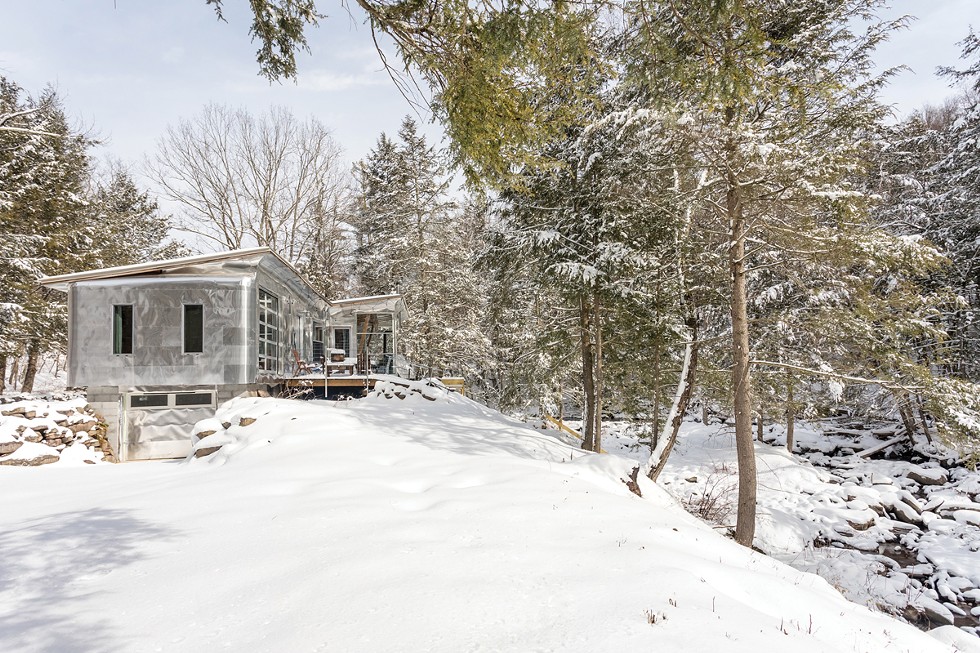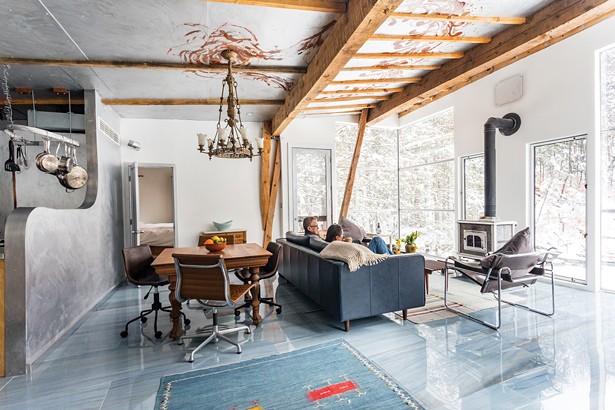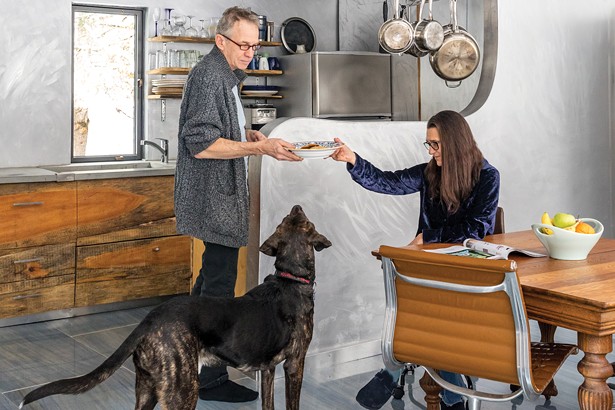Spending decades working with the visually impaired has taught Tom Tobler the value of little blindness. "There are many ways of seeing things," explains the artist, teacher, and designer-creator of a 1,400-square-foot metal home deep in the Shandaken woods. "When I see a tree, I don't just see a tree, I look for the other attributes. What are the smells? There are other cues that make a tree a tree." Gleaming in the snowscape on the bank of the Broadstreet Hollow Creek, reminiscent of a boxcar diner or a spaceship, the convex rectangular structure refracts and reflects the surrounding landscape of trees, boulders, and flowing water. The thoughtful, tactile design absorbs the sensory details of its rugged setting, so that the interior doesn't just offer abundant views but captures the sound of the rushing stream, the arc of sunlight, the scent of the conifers, the rough texture of pine, and the feel and even taste of the loamy forest floor. The landscape washes over the home while still sitting apart from it.
Handbuilt by Tobler over 10 years, the home's design was inspired by the setting, the trailer that once stood in its place, and the many restrictions Tobler encountered during construction. Both special education teachers in New York City, Tobler and his wife Carla Lovas first came to the Catskills 20 years ago. "We had a perfect balance," explains Tobler. "One-hundred-and-eighty days of city life and 180 days to live in the country."
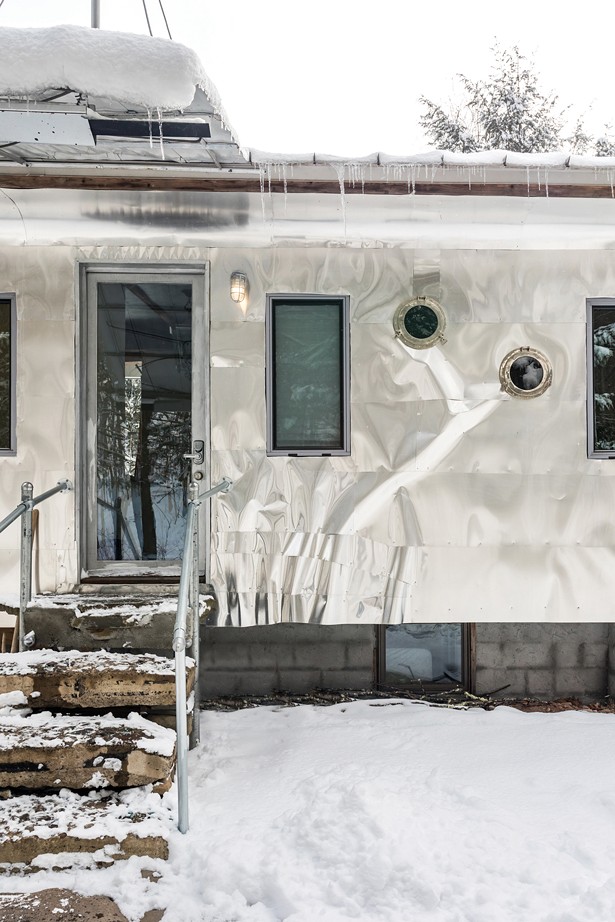
During Tobler's 180 city days, he worked with blind and visually impaired students, teaching them everything from algebra to spelling. "When you teach visually impaired kids you teach them tricks to get around the typical way of doing things, you have to constantly figure out alternative ways of seeing and understand a subject," he explains. In 2013, when the two found three rugged acres in the New York City watershed, Tobler wasn't deterred by the project's inherent limitations—bureaucratic, geographic, or otherwise. What he saw was the chance to practice what he preached as a special education teacher, visualizing beyond the limitations of the site to create something completely new. Or, more simply: "This is how I got my ya-yas out," Tobler explains.
A Complete 180
Lovas and Tobler's hybrid lifestyle grew out of their differing backgrounds. Lovas is a native New Yorker. Tobler came from Vermont, where he lived in the forest. He moved to Bennington to study ceramics before relocating to Manhattan to attend the School of Visual Arts. The couple met while working together in a Manhattan restaurant. "It was like Frankie and Johnny, but with a happier ending," recalls Lovas. They both decided to become New York City teaching fellows and attended CUNY's Hunter College to obtain their certifications. Lovas began working as an ESL teacher, traveling to schools throughout Manhattan on her scooter.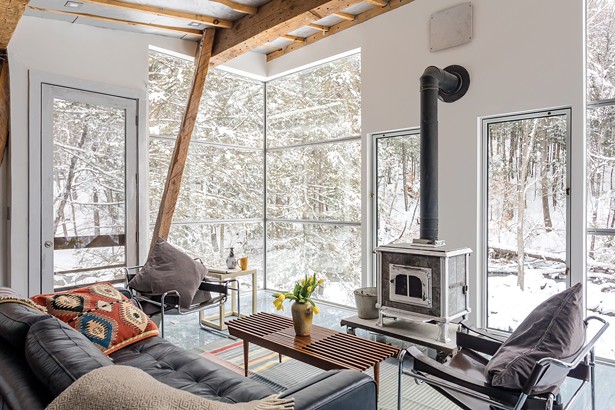
While completing graduate school, Tobler realized that his artist's education could lead him in an unexpected direction. "When I read the list of needed specialties, art teachers were at the bottom because of funding cuts," he explains. "But there was a strong need for teaching visually impaired students." Tobler admits he's always been a very tactile person, using his hands to explore the material world's bend-ability and mass. Art school had also sharpened his visual skills. "I'm visually acute," he explains. "I felt I could teach students how to see."
Don't Argue with Limitations
The couple's first foray into shared country life was a weekend home on a river bank in Pennsylvania. They migrated to part-time Hudson Valley life 20 years ago for the ease of access to Manhattan and the area's rich cultural life. Tobler built a post-and-beam home near Woodstock, but the two always missed being near water. They began looking for property nearby to recreate the river life they'd had in Pennsylvania. Lovas found their boundless three acres online. "It was all about the stream," she explains of the couple's immediate attraction to the property. "The stream has beautiful waterfall drops that wrap all the way around the property. Beyond the water there's nothing but woods."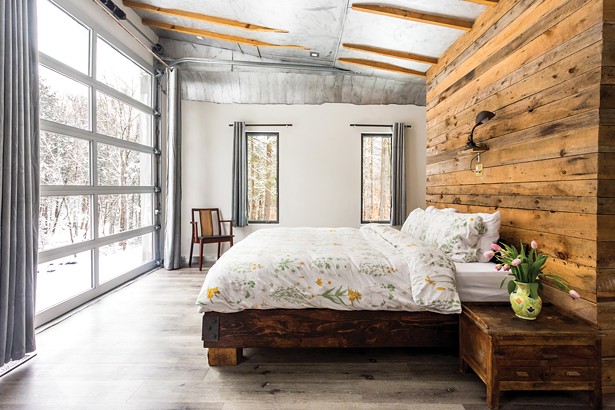
However, the couple's dream lost-in-the-woods acreage came with a catch: "It had this horrible boxy mobile home," Lovas says. "With rotted paneling and lots of mice." Because the land is in the New York City watershed, it's use is severely restricted. In order to build, the couple had to utilize the trailer's original footprint and match its modest size—so no building up a story or out. "If we moved the trailer, we couldn't build here," says Tobler. "We've had friends who made the mistake of removing structures on watershed land and losing their building permits completely." Part-time residents without bottomless bank accounts, the couple were also limited by the realities of money and time. Fortunately, Tobler has boundless imagination and patience and Lovas had complete faith in his ability to see beyond the project's handicaps.
Trailer, Deconstructed
Tobler felt his way into the home's design, starting with a simple idea. "I always liked Airstreams," he says, "Also, I hate wasting space." He began slowly dismantling pieces of the existing structure, salvaging beams from the trailer's wooden roof, built to protect the original tin roof from snow. Next, he removed the trailer's rusted exterior paneling and windows. "Halfway through that process the trailer just disintegrated," he explains. "I heard a loud crackling and immediately jumped into the basement."He carted the corroded materials away, then tackled the structure's foundation with a rented "rather lethargic" backhoe. "Since this is all stream bed, there were many large boulders and lots of sand," he says. After carefully uncovering the old foundation, he replaced it cinder block by cinder block, exactly matching the trailer's footprint but making room for a finished basement. Tobler cut the home's pine framing himself using an Alaskan chainsaw mill, then added new aluminum exterior siding by hand, mimicking the look of an airstream while testing the limits of the material's flexibility and texture. "It was all tin snips," he explains. "And making sure I wasn't too cut up at the end of the day."
The slow, tedious nature of the process, and the need to deal with a changing roster of building inspectors ("We went through three," says Lovas), worked to give Tobler the creative upper hand. With countless hours spent at the property, through varying seasons and times of day, Tobler soaked up the setting and the feel of it permeated and influenced the new home's design. "I have to spend at least a few hours each week in the woods, or I go crazy," he says. "So I came as much as I could. I could spend hours just staring at the stream."
All Five Senses
With the final design, Tobler admits he "pushed and pushed and pushed" the project's boundaries. To fully embrace the setting and maximize light, he angled the roof toward the stream, creating a south-facing, clamshell-shaped structure. At its center, an open-concept kitchen and living area has 14-foot ceilings and a mix of rough-cut wood cabinetry and beams. Tobler bumped out the living room's south-facing wall slightly, capturing space from the trailer's former screened-in porch, then added floor-to-ceiling windows on three sides. He built the wall's metal window frames and Kingston Glass added insulated panes. A soapstone wood stove on casters can be rolled away in summer, and screens replace some of the room's windows, further opening the home landscape.Tobler recycled the trailer's wood roof as built-in headboards for the two bedrooms. The two bathrooms feature eclectic showers reimagined from reclaimed plumbing. In the primary bedroom, a garage door wall with glass panels can be raised in the warm months, allowing for a breeze and capturing the soothing soundscape.
Tobler has left the basement somewhat unfinished, but is seriously contemplating adding a ping-pong table. However, first he has to refinish the space's concrete floors. He also wants to add landscaping, and maybe some sort of gazebo at the edge of the property. Admittedly, he's dragging his feet on all of this. "It's almost like I have to keep working on the home," he explains. "It's like my long-winded, functional sculpture."







